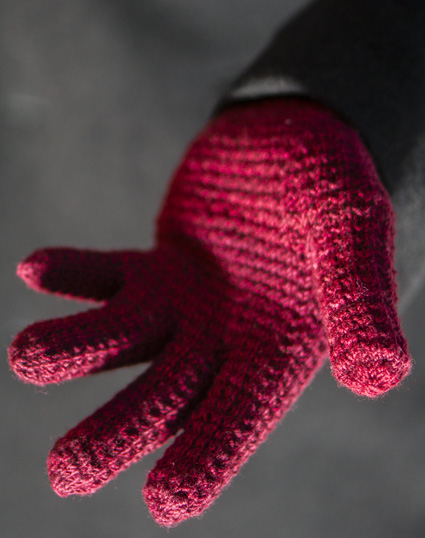

|
|
||
 Adapted by Franklin Habit from Weldon's Practical Knitter, 1st Series (1880s) |
||
|
SIZE |
|
FINISHED MEASUREMENTS |
|
MATERIALS Notions |
|
GAUGE |
| 32 sts/40 rounds = 4 inches in stockinette stitch 30 sts/52 rounds = 4 inches in pattern stitch |
|
PATTERN NOTES |
|
Stitch Pattern. After the cuff, the glove is worked throughout (except for very last rounds of the fingers and thumb) in a simple but effective texture pattern. Take special care at transition points in the glove (for example, when beginning each finger) to maintain the pattern. Texture Pattern Needles. The original pattern calls for DPNs, and although gloves can be made using the Magic Loop or Two Circulars method, to preserve the original very sensible use of spare DPNs instead of holders -- see below -- we've kept the pattern true to that, complete with specific stitch arrangements. If you've worked gloves before, you'll see it can be fairly easily converted to another method of working if you prefer. M1. To increase, use the "make one" increase here that uses the running yarn between two stitches. Historical note: The original pattern indicates that select increases in the thumb gore are purled, presumably to preserve the unity of the stitch pattern. However, it doesn't work and is a pain in the ass to do; so the sample uses only knitted increases. Casting On for Thumb and Fingers. The sample used the simple Backwards Loop Cast On as described here. Sizing Options. As usual, the sizing of the original pattern is extremely vague, giving two options: the man's size translated here; and the identical article knitted with finer (!) yarn and needles for a woman. Also as usual, no information is provided about tension. I have found that the hand as written nicely accomodates a range of hands from a woman's medium to a men's large. The only alteration needed for smaller hands is shorter fingers. If you'd like to give that a try, work each finger until you are about one-half inch shy of the desired length, ending with a knit/purl round; then decrease as written. |
|
DIRECTIONS Work three full repeats of Texture pattern and then knit 2 rounds. Thumb Gore
Work 6 rounds even in Texture Pattern. Arrange stitches before working the thumb as follows: If using stitch holders, slide the sts from Ndls 2 and 3 onto holders, taking care to keep the sts divided on the holders (28 each) exactly as they were on the ndls. If you choose not to use holders, leave Ndls 2 and 3 in place to hold the live sts. You will need two additional dpns to knit the thumb. Thumb Break working yarn and draw through rem sts. Pull tight, then take several sts over the top of the thumb to secure opening. Run the yarn to the WS and weave in end. Upper Hand With an empty ndl, pu and k 4 sts along the base of the thumb, and knit 16 sts from the next ndl (Ndl 2). This is now Ndl 1, with 20 sts. With free ndl, k remaining 12 sts on Ndl 2, then k 8 sts from Ndl 3. This is now Ndl 2, with 20 sts. Starting with Rnd 2, work 29 more rounds in Stitch Pattern (see Pattern Notes), ending with a [K1, p1] rnd. Slip sts of front and back of hand onto two free dpns, dividing evenly (30 each) beginning at the center of the 4 sts CO at the base of the thumb. First Finger Second Finger Third Finger Fourth Finger FINISHING |
| ABOUT THE DESIGNER |
| Franklin Habit (@franklinhabit on Twitter, franklin.habit on Instagram) is the proprietor of the popular knitting blog The Panopticon and author of It Itches: A Stash of Knitting Cartoons. His work appears regularly in major fiber arts publications, and he travels extensively to teach and speak on knitting-related topics. |
| Pattern & images © 2014 Franklin Habit |